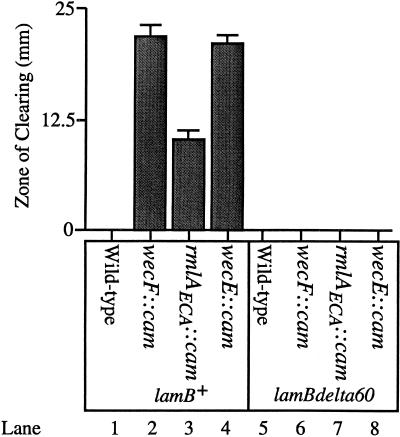FIG. 6.
High-level export of the LamB maltoporin in lipid II-accumulating strains is toxic. Ten microliters of 20% maltose was added to filter discs that had been placed on lawns of the following strains: SP299 (MC4100; ompR101 zja::Tn10 linked to lamB+ λRS88[degP-lacZ]) (lane 1), SP301 (SP299; wecF::cam) (lane 2), SP303 (SP299; rmlAECA::cam) (lane 3), SP305 (SP299; wecE::cam) (lane 4), SP298 (MC4100; ompR101 zja::Tn10 linked to lamBΔ60 λRS88[degP-lacZ]) (lane 5), SP300 (SP298; wecF::cam) (lane 6), SP302 (SP298; rmlAECA::cam) (lane 7), and SP304 (SP298; wecE::cam) (lane 8). The ompR101 allele is a deletion within the ompR open reading frame, rendering the strains described in this figure null for ompR. The lamBΔ60 mutation deletes part of the coding sequence for the LamB signal sequence (8). Thus, strains containing the lamBΔ60 mutation cannot export LamB across the inner membrane. The values displayed along the y axis (zone of clearing) represent the amount of growth inhibition caused by the addition of maltose. The zone of clearing value is defined as the diameter of growth inhibition around the maltose-saturated filter disc, minus the diameter of the filter disc itself (7 mm). All strains were grown at 37°C as described in Materials and Methods.

